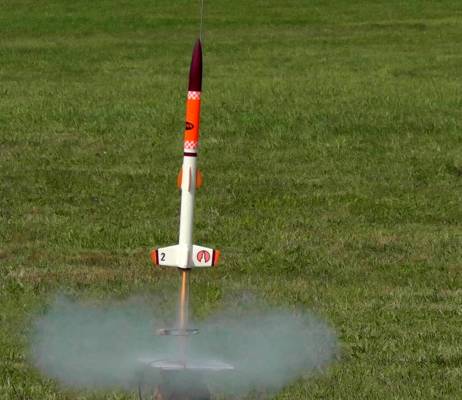The Viper: A '70s kit offered to Estes Aerospace Club (EAC) members. It uses T motors. It is a good, economical flier with parachute recovery. The small 12-inch parachute is a good choice for this rocket, since it is limited to A-power only. I wouldn't waste the time using 1/4A motors unless it's extremely windy or you have an extremely small field, the larger motors are so much more satisfying.
This particular Viper was painted with Purple and Orange instead of the Purple and Yellow. I suppose that was because I had orange dope and no yellow, but that was 35 years ago, who knows?
This rocket was later given my "Iris" modification, which extends the body tube about 5 inches above the streamer / parachute bay, and allows for a payload with an Altimeter One to measure altitudes. With it’s most powerful A motor, I can’t seem to get this above the 200-foot mark. (Iris is named after the Greek god of the rainbow. She is a messenger of the gods, linking the gods with humanity.) This rocket has flown higher than the Cape Hatteras Lighthouse in NC, the tallest lighthouse in the USA.
| Flight Date: | 2012-09-01 |
| Rocket Name: | EAC Viper |
| Kit Name: | Estes - E.A.C. Viper {Kit} (0820) [1972-1986] |
| Flyer's Name: | Rich DeAngelis |
| Motors: | A10-3 |
| Launch Site: | Fort Indiantown Gap, PA |
| Actual Altitude: | 148 Feet |
The strong winds made me take out the Viper again, one of the best windy fliers I have. With the A10 motor’s impulse, it would be up before the wind could find out. The parachute was still the original ‘70’s plastic, and was feeling a bit sticky and melty, so last-minute I replaced it with another 70’s era ‘chute in better condition.
This A10 burned for a measured 9/10th second. Acceleration peaked at 20.1 Gs, highest I ever recorded for this rocket. The average Gs was also higher than ever recorded at 2.6 Gs. This was a powerful motor! It reached the fastest speed for an A10 motor too, at 53 mph. After that it coasted for 2.3 seconds, still going straight up, and hit an apogee of 148 feet. It turned over after apogee and with a slightly long delay of 3.2 seconds it descended 10 feet in 9/10ths second. The parachute deployed and it descended the final 138 feet at 10 mph, ending the flight in 13.3 seconds. It landed only about 30 feet from the launch pad. It was a satisfyingly successful flight.
| Stage | Motor(s) |
|---|---|
| 1 | Estes A10T-3 |
 |
 |
